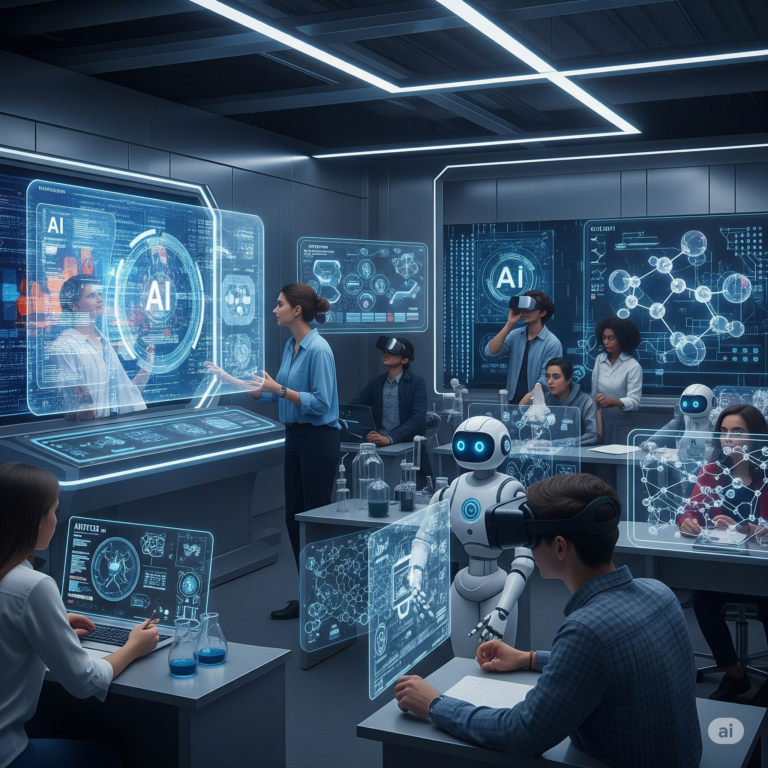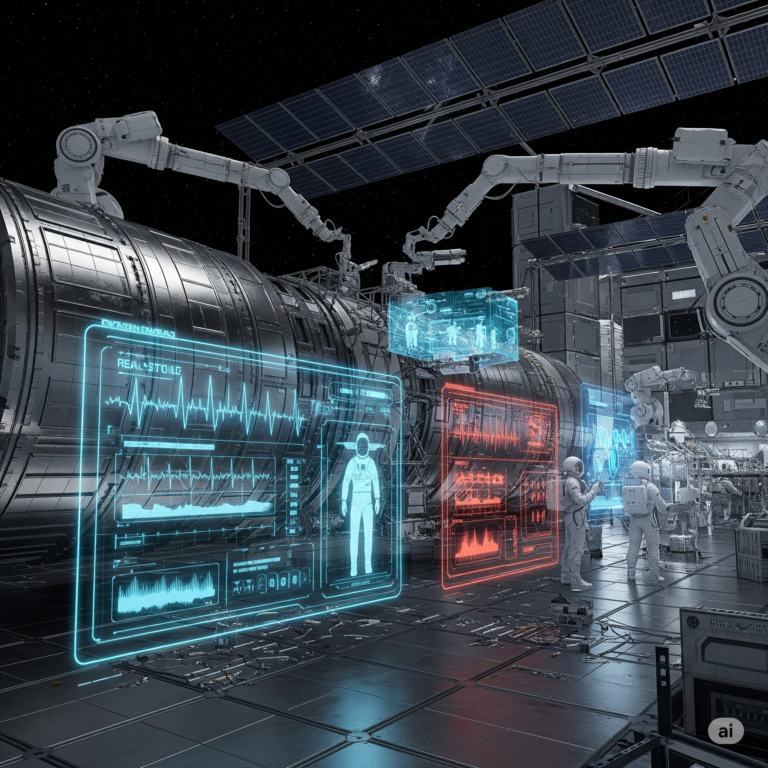Imagine being able to scan the entire stock market in milliseconds, identify profitable trades, and execute them without human intervention — all while managing risk effectively. That’s not science fiction anymore. Welcome to the age of algorithmic trading powered by Artificial Intelligence (AI).
In this blog, we’ll explore how AI is reshaping trading on Wall Street and beyond — from high-frequency trading (HFT) to dynamic risk management, and what this means for investors, regulators, and the broader economy.
What Is Algorithmic Trading?
Definition and Core Concept
At its core, algorithmic trading, also known as algo-trading, is the use of computer programs to execute trades automatically based on pre-defined criteria. These criteria can include timing, price, quantity, or complex mathematical models.
The AI Twist
What makes modern algorithmic trading truly revolutionary is the incorporation of Artificial Intelligence and Machine Learning (ML). AI enables these algorithms not just to follow fixed rules but to learn from data, adapt strategies, and optimize performance in real-time.
How AI Powers Modern Trading Systems
1. Pattern Recognition and Prediction
AI systems can analyze historical market data and detect subtle patterns that are invisible to the human eye. These patterns may indicate future price movements, helping the system make smarter trading decisions.
For example:
- A neural network might detect that certain news sentiment combined with volume spikes often precedes a stock rally.
- AI models can integrate technical indicators with real-time data to predict short-term trends.
2. High-Frequency Trading (HFT)
HFT is a specialized subset of algorithmic trading that involves executing thousands to millions of orders within seconds. AI is used to:
- Predict micro price movements
- Reduce latency in execution
- Optimize arbitrage opportunities across markets
Speed is critical here. AI helps minimize decision-making time to microseconds, giving firms a competitive edge.
3. Automated Strategy Adjustment
Unlike static algorithms that follow a single rule set, AI-based systems can dynamically adjust strategies. They evaluate what’s working and what’s not, adapting to:
- Market volatility
- Changing interest rates
- Political news or unexpected events
This ability to self-tune makes AI trading systems more robust in unpredictable environments.
Key Benefits of AI in Algorithmic Trading
1. Faster Execution
AI systems can process massive volumes of market data in real-time, leading to lightning-fast decision-making. This speed:
- Improves trade entry and exit points
- Reduces slippage
- Enhances profitability in fast-moving markets
2. Improved Risk Management
Risk isn’t just about losing money — it’s about managing uncertainty. AI helps by:
- Calculating exposure in real-time
- Monitoring correlations across asset classes
- Auto-adjusting positions during market downturns
Some systems even integrate natural language processing (NLP) to assess real-time news sentiment and update risk models accordingly.
3. Identification of Complex Patterns
AI can uncover multi-dimensional patterns that combine:
- Price trends
- Volume anomalies
- Macroeconomic indicators
- Social media sentiment
This gives traders insights that go beyond traditional technical analysis.
Real-World Examples and Case Studies
1. Renaissance Technologies
This legendary hedge fund is a pioneer in quantitative and algorithmic trading. Its Medallion Fund reportedly delivers annual returns of over 30%, thanks to AI models analyzing petabytes of data across decades.
2. Citadel Securities
Citadel’s algorithms execute more than 25% of all U.S. equities trading volume on some days. Their AI systems help manage risk, optimize order routing, and minimize execution costs.
3. Retail Traders and Platforms
AI is no longer the preserve of elite hedge funds. Platforms like QuantConnect, MetaTrader with AI plugins, and even Robinhood integrate machine learning tools that retail investors can use.
Challenges and Risks of AI-Powered Trading
1. Increased Market Volatility
AI systems can amplify rapid movements in the market. When multiple algorithms act on similar signals, they may trigger:
- Flash crashes
- Liquidity drains
- Herd behavior
Example: The 2010 Flash Crash saw the Dow plunge nearly 1,000 points in minutes, largely due to algorithmic feedback loops.
2. Systemic Risk
The more interconnected AI trading systems become, the higher the potential for a domino effect. A glitch in one major trading firm’s AI system can ripple through global markets.
There’s also the issue of “black box” decision-making, where no one really understands how a model arrived at a particular trade. This opacity can lead to unforeseen outcomes.
3. Regulatory Scrutiny
Governments and financial watchdogs are increasingly concerned about:
- Manipulative behavior by bots
- Lack of transparency
- Data privacy and misuse
For example, the SEC, CFTC, and European Securities and Markets Authority (ESMA) are working on frameworks to govern algorithmic and AI-based trading.
The Role of Ethics and Regulation
1. The AI “Arms Race”
Firms are in an arms race to build faster, smarter algorithms — sometimes at the cost of ethics. There’s concern about:
- Front-running using ultra-low-latency models
- Data monopolies created by firms with better infrastructure
2. Need for Explainable AI (XAI)
Explainable AI aims to make black-box models interpretable, allowing regulators and investors to understand:
- Why a trade was made
- What risks were evaluated
- How market impact was considered
This will be crucial in ensuring transparency and accountability.
3. Regulatory Sandboxes
Some countries, like the UK and Singapore, have introduced regulatory sandboxes where fintech startups can test AI trading systems in a controlled environment. This approach:
- Encourages innovation
- Prevents systemic blowups
- Builds regulatory trust
Future Trends in AI-Driven Trading
1. Quantum Computing Meets AI
Quantum computing promises to supercharge algorithmic trading by processing complex simulations and optimizations much faster. Coupled with AI, this can lead to previously unimaginable levels of precision.
2. AI in Decentralized Finance (DeFi)
The rise of DeFi platforms is pushing AI into crypto and blockchain-based trading. AI bots on decentralized exchanges can:
- Detect arbitrage between coins
- Manage liquidity pools
- Execute yield farming strategies
3. Federated Learning and Data Privacy
To comply with privacy regulations, AI models may shift towards federated learning, where data remains on-premise and only insights are shared. This balances privacy with performance.
Tips for Traders and Developers Entering AI-Based Trading
- Start Simple – Begin with backtesting simple moving average strategies using Python or R.
- Use Open Datasets – Access free data via Yahoo Finance, Alpha Vantage, or Quandl.
- Practice Risk Management – Always simulate risk scenarios before deploying live models.
- Monitor in Real-Time – Build dashboards to monitor AI trades and override in emergencies.
- Understand the Math – Learn the basics of statistics, probability, and regression analysis.
Conclusion: A Double-Edged Sword
AI in algorithmic trading is a powerful tool, offering speed, scalability, and unmatched precision. It is transforming how markets operate and democratizing access to advanced strategies. But it also brings risks — from flash crashes to opaque systems that evade scrutiny.
Whether you’re a retail investor, developer, or policymaker, it’s vital to understand how these systems work, what they’re capable of, and how to use them responsibly. The future of finance is algorithmic — and it’s up to us to ensure that future is safe, fair, and transparent.









+ There are no comments
Add yours